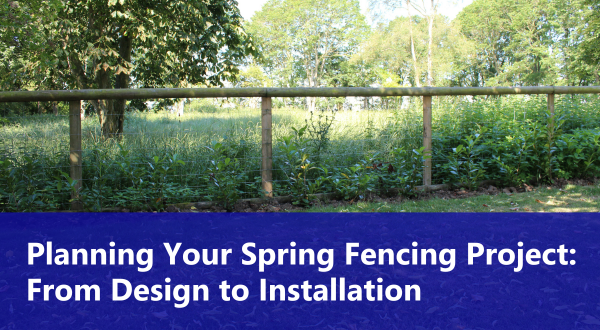PRICE DROP: Selected Softwood Railway Sleepers now available at even better prices!


Planning Your Spring Fencing Project: From Design to Installation
Spring is the perfect season to breathe new life into your outdoor space. As the days grow longer and the weather warms up, many homeowners feel inspired to refresh their gardens and improve their property's boundaries. In this comprehensive guide, we’ll walk you through every stage of planning and installing your new fence—from the initial design to the final finishing touches.
1. Initial Planning and Preparation
Define Your Objectives
Begin by determining the purpose of your new fence. Are you looking for enhanced security, improved privacy, or simply a way to demarcate your garden? Clearly defining your objectives will help steer your design choices and material selections.
Set a Budget
Establishing a budget early on is crucial. Consider the costs for materials, tools, and any professional help you might require. Remember, quality products such as Sure Green fence posts can offer durability and longevity, saving you money in the long run.
Measure and Assess Your Space
Accurate measurements are essential. Walk around your property and note the total length of the fence required, as well as any areas that might need special consideration—such as uneven ground, slopes, or existing obstacles.
2. Designing Your Fence
Style and Aesthetics
Your fence should complement your home’s overall look. Decide on the style—modern, traditional, rustic or something in between—and choose materials that blend well with your property’s architecture and landscape. Consider colour schemes and textures that enhance your garden’s natural beauty.
Selecting Materials
Different projects call for different materials. Common options include:
- Wood: Offers a classic look, but may require regular maintenance.
- Metal: Provides a sleek, modern aesthetic and often needs less upkeep.
- Composite: A durable option that blends the benefits of wood and plastic.
For a high-quality, low-maintenance option, consider Sure Green fence posts, renowned for their strength and longevity.
Legal and Regulatory Considerations
Before finalising your design, check local planning regulations or homeowners’ association guidelines. In some cases, you may need permission or specific design approvals before proceeding with your project.
3. Preparing Your Site
Clearing and Marking
Begin by meticulously preparing your site. Clear the area of all debris, such as fallen branches, loose stones, and remnants of previous landscaping. Remove overgrown vegetation, shrubs, and any other obstacles that might interfere with your fencing installation. It’s also wise to check for any hidden obstructions like extensive tree roots or underground utilities that could impact the positioning of your fence posts.
Once the area is thoroughly cleared, use sturdy stakes and durable string to accurately mark the line where your fence will be installed. Precise measurements and clear markings are essential—they ensure that you stay true to your planned layout. Whether your design features straight lines or intricate curves, mapping out the installation area in advance provides a visual guide that simplifies the construction process and minimises errors during installation.
Soil Testing
The stability of your fence hinges on the quality of the ground it stands on. Conduct a detailed soil test to assess the composition and drainage capabilities of your site. Determine whether the soil is compact or loose, sandy or clayey, as these characteristics significantly influence the foundation's durability.
Based on your findings, decide if additional measures are required. For instance, if the soil exhibits poor drainage or a tendency to retain water, installing effective drainage solutions is crucial to prevent issues such as post rot or shifting. In cases where the soil is less compact, you might need to implement reinforced footings or additional stabilisers to secure your fence posts firmly. Taking these extra precautions ensures that your fence remains structurally sound and resilient against weather fluctuations and ground movement over time.
4. Installation Process
Gathering Tools and Materials
Ensure you have all the necessary tools, which may include:
- Shovels or post-hole diggers
- A spirit level
- Concrete mix (if required)
- A measuring tape
- Protective gloves and safety gear
Installing the Fence Posts
- Dig the Holes: Start by digging post holes at the correct intervals—typically about 6–8 inches wider than the posts. The depth should be sufficient to provide stability, often around one-third of the post’s length.
- Position and Level: Place each fence post into its hole, checking that it’s perfectly vertical using a spirit level.
- Set in Place: For added stability, backfill the holes with a mixture of concrete and water. Allow this to cure fully according to the manufacturer’s instructions before attaching the fencing panels or rails.
Attaching the Panels or Rails
Once the posts are securely in place, attach the panels or rails to complete your fence. Ensure everything is aligned and securely fastened, as this not only affects the aesthetics but also the structural integrity of your fence.
5. Finishing Touches and Maintenance
Adding Decorative Elements
Enhance your new fence with decorative features such as trellises, planters, or even climbing plants. These additions can boost both privacy and visual appeal.
Regular Maintenance
Spring is the perfect time to set up a maintenance routine. Regularly inspect your fence for any signs of wear or damage, and apply treatments like paint or sealant to extend its lifespan. Keeping up with maintenance will ensure your fence remains a beautiful and functional addition to your property for years to come.
Conclusion
A spring fencing project is not only a practical way to secure your home but also an opportunity to add a distinctive aesthetic touch to your garden. With thorough planning, the right materials, and careful installation, you can transform your outdoor space into a stylish, secure, and welcoming area. Embrace the season of renewal and start planning your fencing project today—your dream garden awaits.






